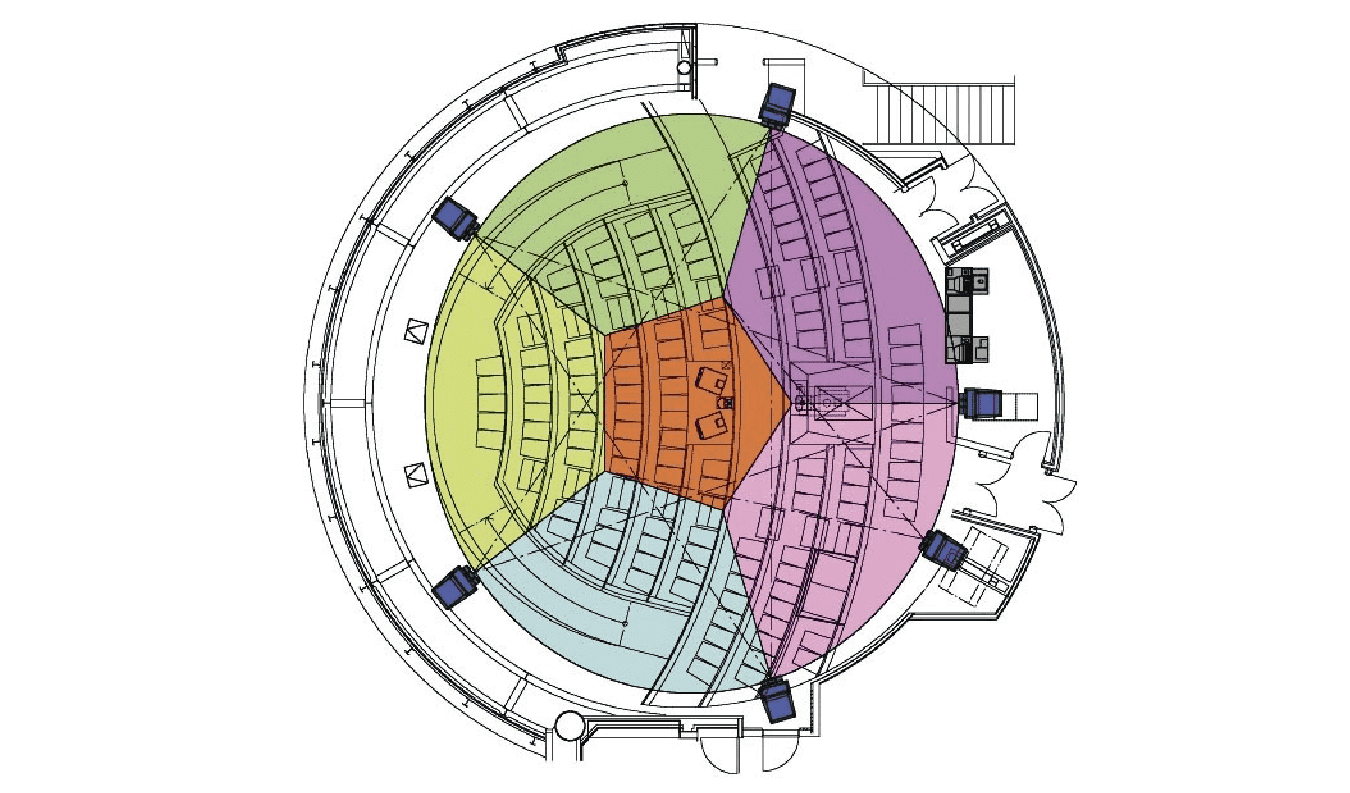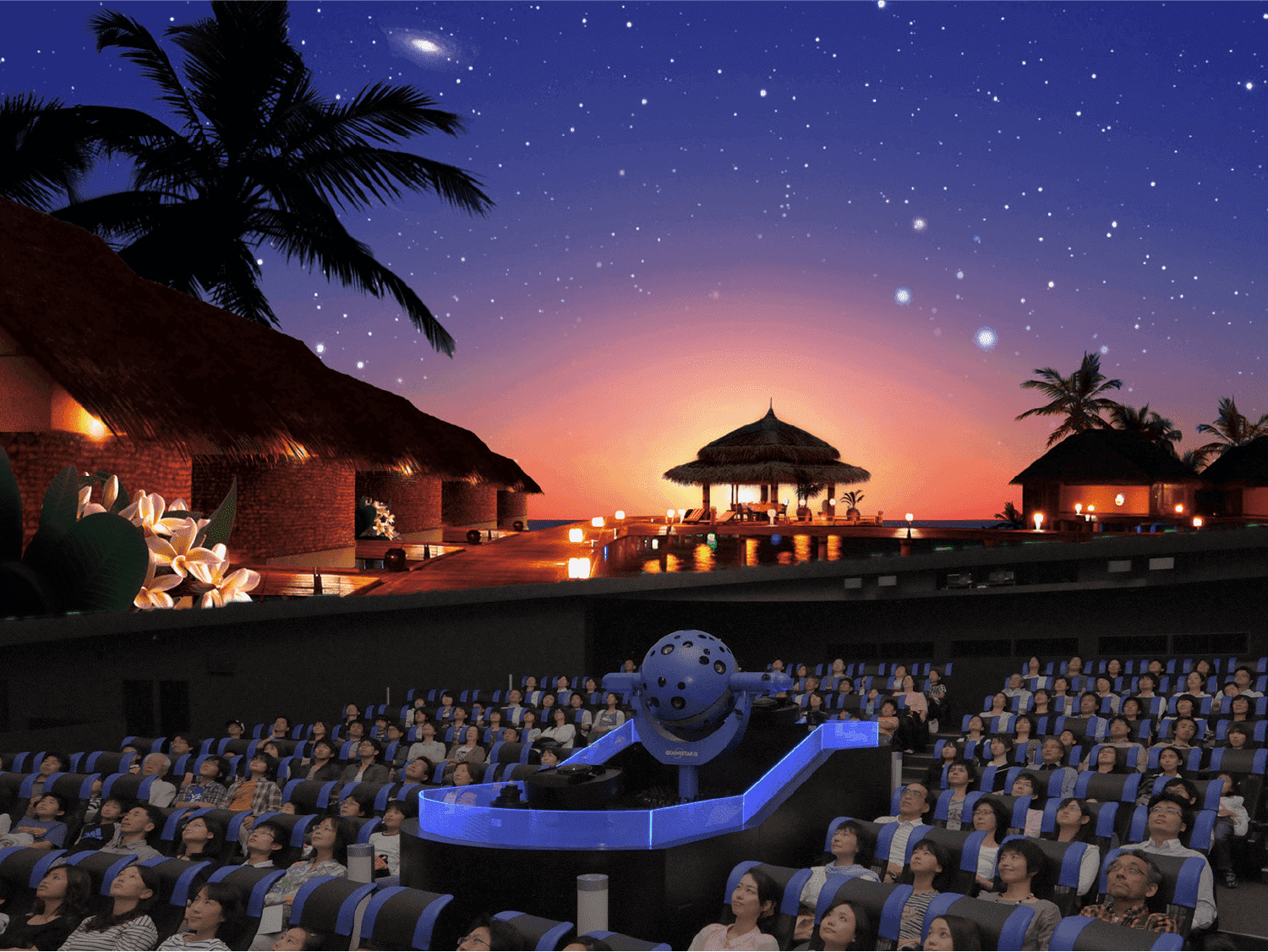INNOVATION STORIES
PLANETARIUM
To create starry skies on the ground and deliver excitement
A planetarium business that honors the founder’s vision
- INDEX
Today, there are over 2,700 planetariums globally. Of these, about 300 are in Japan, making it the third largest country, by number, following the U.S. and China. In 1958, we became one of the first to complete a planetarium system built in Japan and open it to the public.
For more than 60 years, we have created and presented new value around the world as a general planetarium manufacturer that can undertake the entire process, including development and manufacturing of optical planetariums* and digital projectors, show production, design and construction of dome theaters, and theater management.
* Optical planetarium: A system to project light through stellar original plates, which are perforated based on the arrangement of the stars, and then onto a screen via a lens.


Driven by the founder’s dream
The world’s first optical planetarium was developed in 1923, just 100 years ago. It was invented by Carl Zeiss in Germany. Fourteen years later, in 1937, Carl Zeiss’s planetarium was installed at the Osaka Electricity and Science Museum (currently Osaka Science Museum), the first planetarium in Japan. Kazuo Tashima, the founder of Minolta, liked to look at the stars since childhood and frequently visited the planetarium, gradually becoming motivated to develop an in-house planetarium.
Tashima’s dream suddenly moved toward reality when Tashima met Masasuke Nobuoka, an inventor. Tashima invited Mr. Nobuoka as a temporary employee. In 1958, Japan’s first lens projection planetarium system was finally completed based on Mr. Nobuoka’s knowledge about the manufacture of planetariums and lens design technology, which had been refined through the in-house manufacturing of cameras. The planetarium opened to the public at the science exposition in Hanshin Park; an amusement park in Hyogo Prefecture and attracted more than 200,000 visitors during the three-month period.

In 1966, the MS-10, the first mass-production model was completed. It became a bestseller and contributed to the growth period of our planetarium business. More than 50 units were delivered by 2000, of which more than a dozen are still in operation. The MK-II, which was designed as an OEM model for export based on the MS-10, was shipped to various parts of the U.S. This model appears in a scene at the Griffith Observatory in Los Angeles in the film ‘La La Land,’ which won six categories at the Academy Awards in 2017.

A planetarium capable of reproducing the universe as seen from outside Earth
The business reached a turning point in 1985, at the International Exposition in Tsukuba, Japan. We decided to develop a novel planetarium for the exposition, which focused on the theme of science and technology. The development concept was an “outer space planetarium.” While conventional planetariums reproduced the starry skies seen from Earth, the new planetarium was designed to reproduce starry skies seen from other planets within the solar system.
To realize this concept, engineers gathered from various sections of the company. Previously, the system integrated two globes in order to project starry skies of the northern and southern hemispheres, and a projector for the Moon and planets. For the new planetarium, the system was separated into a single-globe star projector and a planet projector. This led to the development of Infinium, a single-globe planetarium featuring cutting-edge technologies. The compact planetarium, which hardly obstructed the view of the audience was popular, together with the tilted dome of 25.6 m in diameter and was the largest in the world at that time. From this period up to the early 1990s, the number of planetarium units installed, particularly in large domes, peaked. The introduction of our planetarium units continued to increase during this time.

Meanwhile, Evans & Sutherland, a U.S. company, released Digistar as the forerunner of digital planetariums. At first, monochromatic wireframe images were projected, yet changes in the positions of stars, depending on the differences in distance from the Earth, were reproduced. This unique capability was unattainable by optical planetariums. The shape of Orion changed dramatically as the viewpoint shifted from Earth, and offered a new audience experience, so they could appreciate the depth of the universe.
We developed Gemini Star, the world’s first integrated planetarium that combined Digistar II, a successor model of Digistar, with Infinium and installed the first unit in 1997. Later, we released SKYMAX, which projected a full-color image on the entire dome by combining images from multiple projectors. The combination of realistic and beautiful starry skies, reproduced by an optical planetarium with full-dome CG images, set the trend for new planetariums.

Keeping the lights on
The International Exposition, Tsukuba, was followed by an unprecedented boom and an interest in science that coincided with an economic bubble in Japan. Local governments across Japan competed to construct planetariums, resulting in surging domestic demand. However, when the economic bubble burst in the mid-1990s causing the budgets for public works projects to shrink, the planetarium market plunged.

At that time, we learned about the decision to close the Sunshine Planetarium in Ikebukuro, Tokyo. The planetarium was one of the few privately-run facilities in Japan and attracted the second largest number of visitors. When we heard the news, we considered multiple options to keep the planetarium running as a partner company, and also wondered whether or not the number of astronomy fanatics, and people interested in the universe, had really decreased. On the final day in June 2003, the Sunshine Planetarium was full to capacity. We witnessed firsthand the feelings of visitors who lamented the closing and received many requests to keep the planetarium open. These made us even more determined than ever to seek solutions.
We finally decided to manage the Sunshine Planetarium by ourselves. There were only a few planetarium manufacturers in the world. There were no other planetarium manufacturers taking on facility management. It was apparent that we did not have the management expertise for an undertaking of this magnitude. At first, most of our top management executives were against the idea. The decision was a tremendous gamble.

Back then, and with various facilities being closed one by one, the revival plan by a manufacturer turned out to be a very welcome one. We were interviewed by various media as an auspicious topic of the new Konica Minolta, whose management was integrated in August 2003. In March 2004, Sunshine Starlight Dome “MANTEN” opened with tremendous fanfare.
“MANTEN” presented multiple shows of different types each day, such as a program to fully appreciate the beauty of starry skies, another program in which impressive CG images were projected 360° onto the entire dome, and finally a healing program to experience relaxing shows with aromas. Many unique arrangements were made, such as scheduling the healing program at night so that workers could drop by on their way home. The planetarium attracted significant public attention, and the number of visitors in 2004 reached about 330,000.
With “MANTEN” as the beginning, planetariums under the direct management of Konica Minolta were opened one after another, in TOKYO SKY TREE TOWN®, Yurakucho Mullion, Nagoya, and Yokohama. We established the image of planetariums as entertainment facilities. Other planetariums across Japan started to use digital images and offer multiple programs, helping more and more people to become interested in planetariums.

To deliver impressive shows
Not only have projectors changed over time, but so have the presentation of the shows significantly. It is still the standard presentation style to explain how to find constellations by showing lines connecting stars alongside narrated mythological stories, while presenting constellation pictures. Furthermore, images that make programs more attractive or help deepen our understanding of the contents have changed from still images, to using a slide projector, to videos in a square frame, and finally to using a video projector. In the late 1990s, it became possible to project almost any video on the entire dome. And even though technical restrictions still existed, producers endeavored to make programs as enjoyable as possible by demonstrating their creativity in any scenario. In line with the expansion of imaging capabilities, they started to make this “full dome content” even more attractive.

The show production practices changed significantly with the establishment of “MANTEN,” a planetarium under the direct management of Konica Minolta. Previously, most shows were produced at the request of those in charge of the facilities to which our planetariums were delivered. However, at Konica Minolta’s planetariums, we were responsible for planning and producing shows that met the needs of the audience as well as checking their reaction during shows. This led to the production of programs in collaboration with famous musicians or featuring TV personalities as narrators or programs focusing on certain countries and regions, while linking their geographical features with starry skies.

Another challenge was to upgrade programs to feature anime characters that children love. At first, characters appeared in programs, but only as still images due to contractual restrictions. They were rather like electronic picture story shows. Then, an employee in charge of show production made a breakthrough, negotiating with a major animation production office and successfully presenting a full animation program in 2009. Subsequently, shows present original stories feature popular characters in full animation were established as a standard category at planetariums.
A variety of shows are presented at Konica Minolta’s directly managed planetariums and many other planetariums across Japan. Connected Dome Library, a subscription Cloud service to stream shows, has also been launched.

The evolution of equipment has also been accelerating. A vision system with LED panels arranged in a dome shape was introduced to Konica Minolta’s planetariums in Nagoya and Yokohama. Unlike a projection system using a projector, the entire dome serves as a huge monitor in the LED dome system, producing high image quality and brightness as well as unparalleled contrast and color. Beautiful starry skies and highly realistic images are realized at the same time, providing an overwhelmingly vivid experience. In the future, the system could be used for other purposes, such as live streaming of concerts and e-sports.
A variety of shows are presented at Konica Minolta’s directly managed planetariums and many other planetariums across Japan. Connected Dome Library, a subscription Cloud service to stream shows, has also been launched.
The evolution of equipment has also been accelerating. A vision system with LED panels arranged in a dome shape was introduced to Konica Minolta’s planetariums in Nagoya and Yokohama.

Unlike a projection system using a projector, the entire dome serves as a huge monitor in the LED dome system, producing high image quality and brightness as well as unparalleled contrast and color. Beautiful starry skies and highly realistic images are realized at the same time, providing an overwhelmingly vivid experience. In the future, the system could be used for other purposes, such as live streaming of concerts and e-sports.

While planetariums are state-of-the-art vision systems, the founder’s vision of delivering excitement through starry skies has remained unchanged. We received a letter from a visitor who watched a program: “We are here on Earth thanks to many miracles that occurred after our planet was formed. The program reminded me that I am not alone, so I was motivated to live.” Staff members at that time said they were amazed by the power of planetariums and the message from this letter renewed their commitment to this business.
We will continue to deliver unique experiences and excitement that exceeds the visitor’s expectations. This, along with our ongoing vision to display the most impressive and beautiful starry skies, will provide a space that arouses our visitor’s never-ending curiosity to hopefully continue to discover the wonders of the Universe.

In the interest of clarity, “Konica” and “Minolta,”—the trade names that were used before the merger that formed “Konica Minolta”—are used throughout this text. Each company underwent a number of name changes throughout their history.

